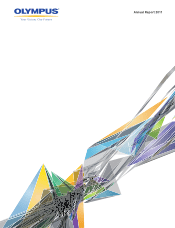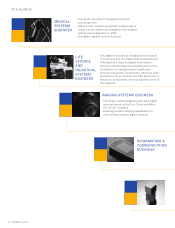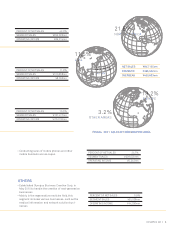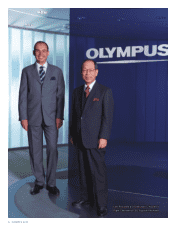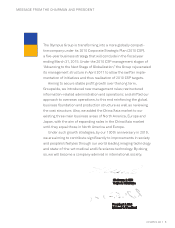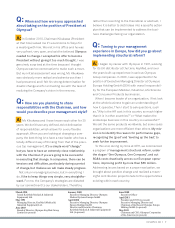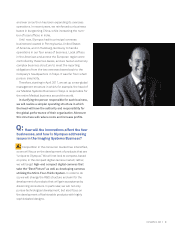Olympus 2011 Annual Report Download - page 10
Download and view the complete annual report
Please find page 10 of the 2011 Olympus annual report below. You can navigate through the pages in the report by either clicking on the pages listed below, or by using the keyword search tool below to find specific information within the annual report.
8 OLYMPUS 2011
What issues does Olympus
currently face?
A: Currently, Olympus’s SG&A (Selling, General &
Administrative) expenses account for 41.6% of net
sales. This is a very high figure and we must start with
reducing these costs. However, such cost reduction
must not be taken for the sole purpose of pursuing
short-term gain; the sustainable improvement of our
Company depends on the improvement of the entire
manufacturing process from product planning and
development, through to production and distribution.
Olympus has the technological engineering resources
and corporate culture needed to develop high-quality
products that customers want to buy. As part of our
improvement activities to address the current issues,
we will reduce costs, generate profit through more
efficient management, and invest this profit in the
development of even higher quality products. Through
the positive cycle of manufacturing and development,
Olympus can expect to achieve sustained profitability
over the long term. Therefore, we should not reduce
investment in R&D as part of our cost-cutting initia-
tives; rather, we should focus on operational processes,
for example in logistics, improving the distribution of
products from factory to market.
Moreover, profitability differs among businesses,
and we have to look at each one individually and take
different approaches to each.
What is your assessment of the impact
of the Great East Japan Earthquake on
business?
A: I left Japan just a few days before the earth-
quake. Words could not describe the images shown
through the news media in the days following these
tragic events. Returning to Japan shortly afterwards,
I found it was one of the most moving experiences of
my life. I have always had affection for Japan, but it
increased dramatically when I saw how the Japanese
people were dealing with such tragedy, working
closely together and coping with it with dignity.
Our Shirakawa Factory, which manufactures
electronic units for medical endoscopes, was affected
by the earthquake. The initial evaluation was that
manufacturing at Shirakawa could be out for many
months, but we actually resumed operations within
just three weeks. I really appreciate the way in which
our local production staff worked around the clock to
make this happen and our medical supply chain will
be fully restored before summer. The manufacturing
of consumer products is also expected to get back on
track this summer. Although our endoscope business
was affected the most, we developed a scenario of
business recovery for the second half of fiscal 2012
based on projections for the prompt recovery of
production lines.
Please tell us about key management
issues you will tackle in fiscal 2012.
A: In fiscal 2012, we have already commenced cost
reduction measures under the new management struc-
ture, and we expect our fiscal 2012 results to exceed
those of the previous year.
To achieve this, we have four issues to address: First
and foremost, we will reduce our SG&A costs. Then we
will focus on recovery in the Imaging Systems business
and reinvigorate the microscope business, before turn-
ing our attention to increasing the profitability of our
businesses in the Americas. As for the key issue of cost
reduction, we recently launched the “COST CUTTING
20” campaign to improve the ratio of “SG&A costs, other
than R&D costs, to net sales” by 20% by fiscal 2015.
Olympus changed the management
structure from this April. What is the aim of
this change?
A: Olympus is one of the Japanese companies that
pioneered international sales back in the 1960s, set-
ting up subsidiaries in Europe and the United States,
INTERVIEW WITH THE PRESIDENT
A:
A:
A:
A:

